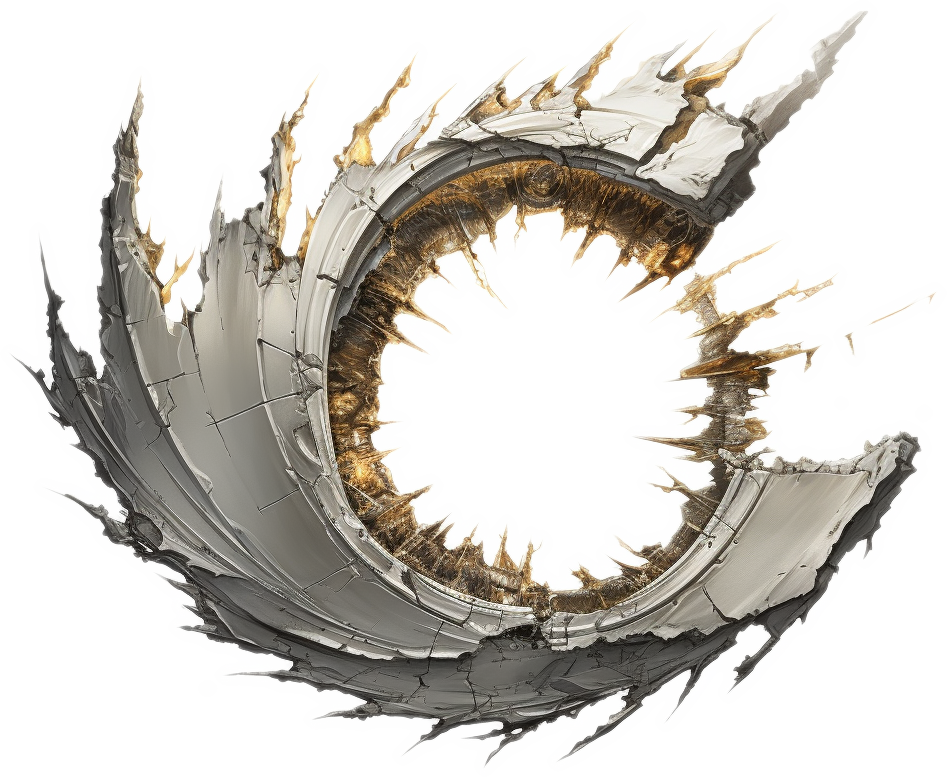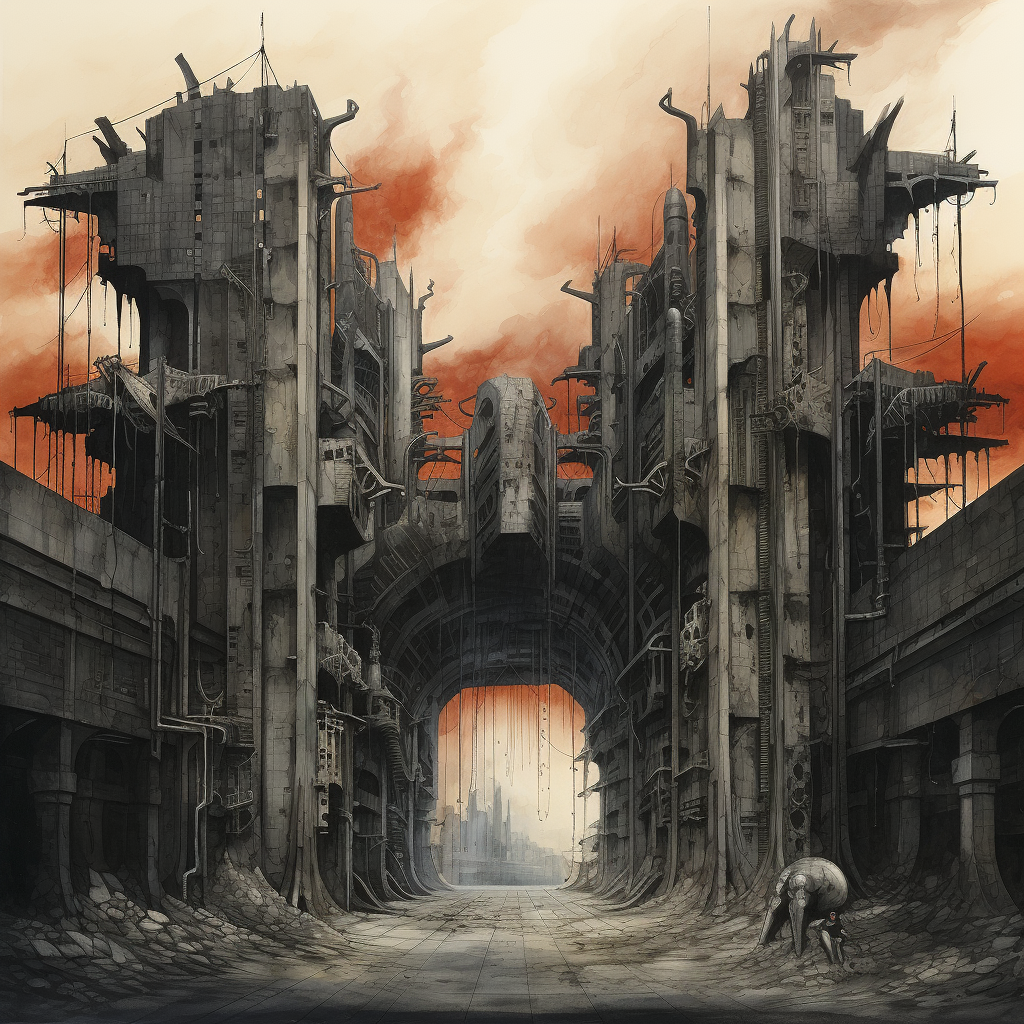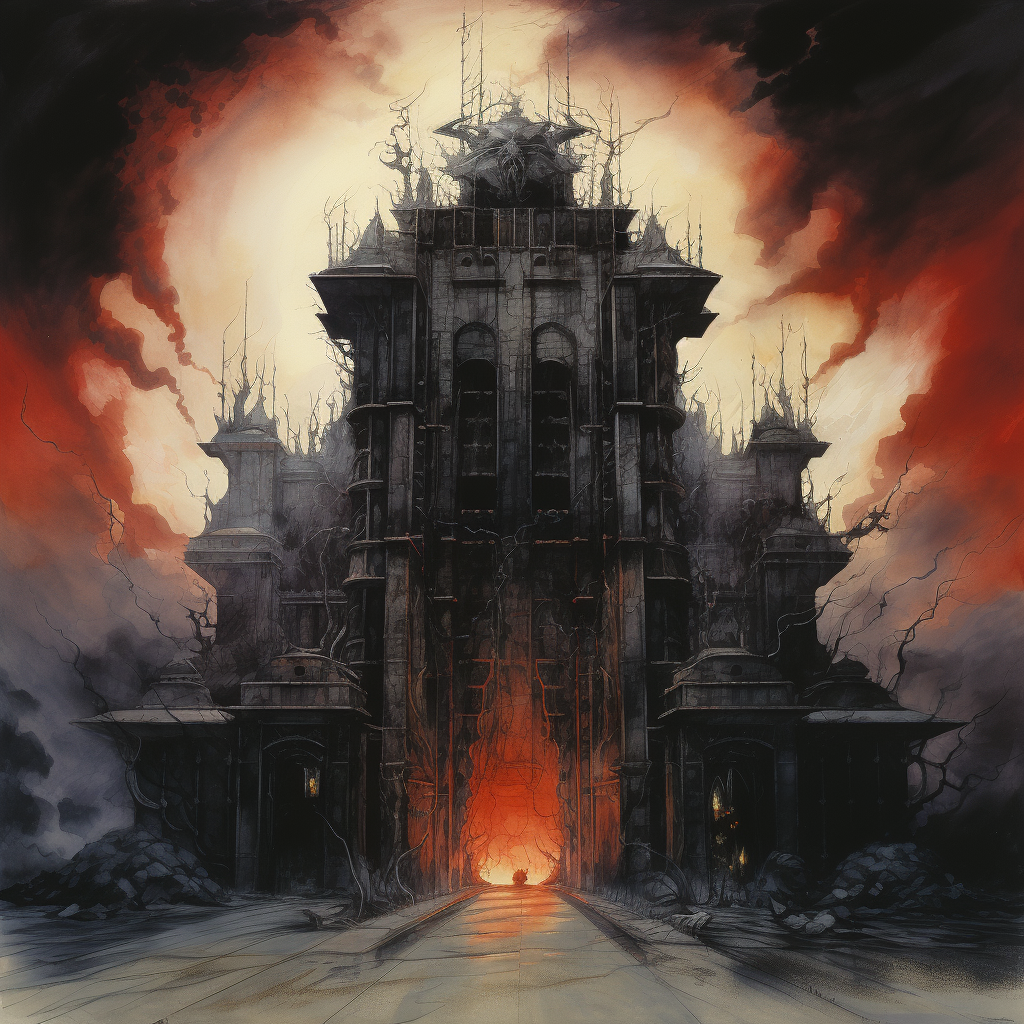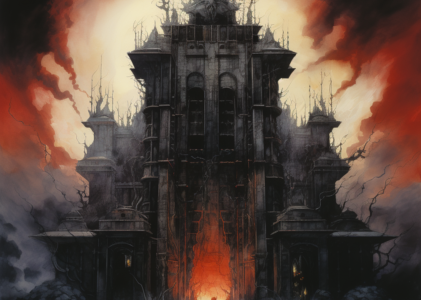The Charnelhouse
“Then the horrid law-ones came with their slabs of stones that sang horrorscreamy songs of sweetness and death; and they poisoned themselves a mountain of woe from our tender bonesy flesh-bodies and belched it into the sky; and all about them was sleep and ruin. But we rose up against them, beloved, pure and primal in our passions, and we drove the orderfiends from our lands and clove their mountain in twain and wrapped their blessed stench about them like a noose and rained joyous death upon the sleepmakers, and all was fury and good.”
– from the archives of Al-ha’ksha!chulam, tanar’ri memory, as translated from the Ancient Tanar’ri by Hexatlor Meerschaum (deceased)
The Charnel House is a place of peace that the tanar’ri fear above all else.
It waxes and wanes like a wound that never heals.
It is the incarnation of the baatezus’ deepest desire.
Background: The Blood War rages on eternally; this we know and can never change. Like all things, though, it had a beginning. Both sides may have hated each other from the start, but hatred is not action and wounds do not gush forth absent blows. There must have been a first blow struck, a first crime committed, a first moment when the multiverse slid into madness. One can still find scars from the first tanar’ri incursions burned haphazardly into the flesh of Baator, but in the whirling chaos of the Abyss only one baatific monument remains: The Charnel House.
Description: At first glance it appears to be a giant complex some five miles across located in the Plain of Infinite Portals, circumscribed by a ring of charred dirt two feet wide. Outside, the ground looks normal for the Abyss; inside, the eerily smooth soil is occasionally churned and pockmarked by dark, unknowable stains. Canny planewalkers notice that the complex seems squeezed somehow, as if too much matter is filling the space inside. Everything looks just slightly out of focus, all distances and angles are slightly warped, yet the structure itself looks regular enough to have been birthed in Mechanus.
The complex is roughly circular in shape, low-lying buildings on the outer ring giving way to a series of large warehouse-like buildings that finally yield to a huge granite edifice in the middle, the Charnel House itself. Four great roadways bisect the circle, paved in smoothest obsidian. Many of the smaller buildings are in complete ruin — often appearing to have been destroyed in some furious rage — but the central buildings have remained more or less intact, with just the occasional scorching to indicate that the previous inhabitants did not leave peacefully.
The air is both rank and dry at the same time. There are traces of fire and brimstone, traces of blood and ichor, traces of smoke and destruction, but underlying all these smells is a subtle perfume that cannot quite be identified. It is sweet and lingers on the palate, causing tanar’ri to retch violently and baatezu to feel an unfathomable sense of joy. The sky above is hazy, yet leaves the impression that once the haze parts there will be a light more pure and radiant than the Abyss has ever known.
All around there is a great sense of peace and finality, like an awful weight that presses one into sweet oblivion. Chaotic entities, in particular, find this enforced peacefulness brutally oppressive and will either sink into a stupor if they are too weak to fight or burst into a furious rage if they can resist.

Buildings: The low-lying buildings that survived the Great Devastation are empty. They seem to have served as barracks of some kind, but whatever fate befell the complex left only splinters, ash, and more of those peculiar dark stains. Tanar’ri will find it impossible to proceed any further, overcome with a strange feeling of peace and terror that they cannot resist; tanar’ri tieflings (including cambions and alufiends) can, though they will be trembling with unspeakable emotions.
The next ring of buildings look like large warehouses. Inside most are large livestock pens, replete with huge rusted chains to tether the animals, though the cages themselves have mostly been destroyed. More of the dark stains linger here, accompanied by a few unrecognizable bone fragments. Travelers exploring here for more than ten minutes will notice that the air has an unpleasant, organic quality that aeons of absence have not been able to erase.
A few of the large buildings seem to have once been offices of some kind. Broken globes hanging from the ceiling indicate that these places were once well-lit, though they are dark and shadow-filled now. Hundreds of yards of what appear to have once been filing cabinets line the walls, interspersed with what must once have been desks. Most the cabinets have been destroyed, surrounded by the ashes of their contents, but a few are intact enough to open. Inside are ancient pieces of parchment covered in lists that are written in some unrecognizable language. The few lists that are still legible indicate that each item has been very precisely crossed out; what they signify is unknown, though those familiar with the early history of the Blood War might guess that they were names.
The office buildings appear to have been savaged far worse than the livestock pens, as if whoever destroyed them was personally outraged by the desks and filing cabinets, yet there are no dark stains to witness their passage. What they contained, and what they were cataloguing, is a mystery that has been lost to the ages.
Horrorscreamy Songs of Sweetness and Death: As one proceeds to the center of the complex, a strange lilting air is heard through the skin. It wafts and flows like a sylvan nymph, yet induces an eerie lassitude that saps the will. Chaotic entities react violently, as if they are being torn apart by peace and rage at the same time; neutral ones, though aware of the lassitude, are affected instead by a profound sense of uneasiness and fear; and lawful ones begin to feel a certain horrible “rightness” about the place that calls them to lay down their tasks and merge themselves with the new order.
The feeling is most profound when near the great stone pillars that dominate the complex. Fully fifty feet high — taller than any structure save the Charnel House itself — they are inscribed with markings that seem to actively lie passive upon the surface. The stones towards the outer ring of the complex are in ruins, some actually broken in twain, but those towards the centre are intact save for some slight scorching. The ground around each stone is tainted by myriads of those dark stains and piles of petrified substances that cannot be identified.
Also unidentifiable is the substance from which the pillars are made. Though at first glance they, like many of the larger buildings, appear to be constructed from granite, a closer inspection — if one can survive the proximity — indicates that this is like no granite anyone has ever seen. It’s unnatural even for the Abyss; smooth and stone-like to the touch, yet possessed of a deep emptiness that seems to draw in the spirit and leave nothing behind.
Those who succumb to the stones’ dark song become passive and pliable. They will follow any instruction without question, no matter how stupid or dangerous. The effect only wears off once the victim has left the complex. Upon their return, they will succumb once more.
The Charnel House: The four great roads meet in four huge iron gates at the central structure, the Charnel House itself. Three of the gates are damaged but functional; the fourth, hanging limply from its broken hinges, appears to have burst outwards and its obsidian road has been shattered beyond all recognition. Hacked above the gates is a symbol that looks like an oddly-formed baatific rune signifying “the calm after the battle has ended and all those involved are slain”; only scholars will recognize it as Classical Baatorian, with a meaning now lost to the Baatezu language: “Peace”.
The building itself is huge, at least 200 feet tall and nearly a mile wide, surmounted by a small cylindrical tower from which the haze seems to emanate. It is made from the same stone-like material as the pillars, but lacks runes or markings and induces no lassitude to those who stand in its shade. Careful examination reveals that the outer wall, though smooth on casual inspection, was once covered by carvings of some kind, but these have been erased and a random flowering of fine cracks riddle the surface instead.
Beyond the gates lies a great vault that takes up nearly all the building’s interior space. Strange devices in the ceiling are dark and dead but give the impression that this was once a heavily trafficked place. The largest of these is a crystalline orb, now cracked, which is surrounded by hundreds of eye-like windows. The lassitude, returned with full force, takes on a chill tone here, the source of the completion.
Unlike the rest of the complex, which seems to have been orderly before its destruction, the walls here were repeatedly damaged and inexpertly sealed. Huge rents gash the floor, desperate claw marks rake the walls, and a strange smell of ichor permeates the almost cloying sweetness of the air. Touching any of these marks fills the recipient with a combination of terror and rest so powerful that it will kill a lesser sod and drive even the mightiest blood as barmy as a Bedlam mazerat. Even without touching the marks, strange visions seep into one’s mind like a miasma. Visions of horrors unimaginable, of a million screaming demons, of nightmares beyond comprehension coughing up their viscera in anguish as mirror-eyed fiends stare impassively down from the windows in the ceiling.
The longer one stays in the vault, the greater one’s nervousness grows. The shadows loom more harshly, the quiet seems broken by screams just beyond earshot, all without movement or sound. Ultimately, a blood will flee in terror from the stillness of vault and won’t stop running until they have fled the complex, lest they be overwhelmed by the memories buried within.
Despite the possibility of rooms behind the windows high above, there is nothing anywhere in the Charnel House. Nothing but the memory of death.

The Dark – History: In the early days of the Blood War the baatezu managed to capture the Plain of Infinite Portals. Lesser minds would have simply set up camp there and tried to drag it into Baator by main force of belief, but this was insufficient to avenge the horrors the baatezu had suffered. Coldly, logically, hatefully, the baatezu realized that there was only one solution: Genocide,
The Charnel House was their greatest weapon. Hacked from the unliving stone of the Grey Waste itself and carried to the Plain by a million yugoloth drudges, it broadcast waves of lethargy that turned vibrant tanar’ri into passive, pliable slaves. At its height, the Charnel House was single-handedly responsible for the “pacification” of over two hundred Abyssal layers. Tanar’ri who entered those layers found their will sapped until they keeled over and followed their new baatezu masters back to the holding pens of the Charnel House. Back to their doom.
The vault of the Charnel House is the greatest mass-murderer in history. It had but one purpose: extermination.
Day after day, thousands of tanar’ri would be marched into the vault where they would be made to lie down, unable to resist the orders of their hated overlords. Day after day, the baatezu would flood the vault with horrific toxins garnered from Carceri’s festering rot and subtle magics designed to break down their victims’ natural resistance. Day after day, thousands of tanar’ri would spasm out their last, their base desire for life succumbing to the terrible passivity. Day after day, thousands of tanar’ri bodies would be rendered to ash and dust then spewed forth from the chimney above, producing a hazy plume several hundred miles wide.
This was the baatezu’s monument to perfect peace.

The Dark – Alignment: Eventually the tide of the war turned and the baatezu were driven from the Abyss. Unable to destroy the Charnel House, the tanar’ri did the next best thing: they exiled it.
The Charnel House now exists in an Abyssal paraplane, a fragment of reality ripped from the plane and spent spinning outwards into the void. It’s usually inaccessible to all but the canniest of powers and not even the mighty Lolth or Graz’zt have figured out how to enter the Charnel House when it’s at its apbyssion [Ed. note: position farthest away from the Abyss]. Nevertheless, for some unknown reason it occasionally spins back into alignment with the Plain of Infinite Portals. When it does, a mysterious bubble of pseudo-reality about five miles across pops into existence, somehow displacing everything around it without really moving anything aside.
Although the soporific tyranny of the Charnel House was broken long ago, it still emits a dank aura that will absolutely enrage any tanar’ri in the vicinity. The usual mayhem of the Plain will suddenly swell into a torrent of violence horrific even by Abyssal standards, so intense that every baatezu team sent to investigate has been swept away without a trace. After a few days, the paraplane moves out of alignment and the Charnel House disappears once more. Few tanar’ri are aware of its existence as anything more than a myth, even those who’ve been tainted by it; something about the way it veers in and out of alignment makes it almost impossible to find except by accident.
Rumours: The primary rumour concerning the Charnel House says that it’s due to come into alignment soon and not by natural means. Who is behind this unnatural alignment isn’t known; various chanters will claim anyone from the usual suspects (Graz’zt, Lolth, the General of Gehenna) to more complicated schemers (Asmodeus, the Oinoloth, Loki), to some truly outrageous, yet still dangerously plausible, string-pullers (Thoth, Sung Chiang, Zaphkiel).
The secondary rumor is subordinate to the first: somewhere in the upper reaches of the Charnel House itself is said to be the secret of its construction, a secret the baatezu make no pretense at wanting back. [Think, cutter: if they could build something like the Charnel House whenever they wanted, the Blood War would’ve been over aeons ago.] Hundreds of them-in-the-know will pay pretty jink for even a scrap of that knowledge; thousands more will pay dearly to prevent them from finding it out.
The final rumor floating around is odd, but more intriguing than the others. Ezehill Balanstan (planar wizard [he/him] / LN), a Sigilian loremaster, has become convinced that the alignment of the Charnel House follows an underlying logic and that understanding its peregrinations will unlock the secrets of the multiverse (or at least the chaotic side of the Wheel). He’s prepared to offer some serious coin to cutters who can make their way into the paraplane and conduct some experiments on his behalf. What those experiments are, and what they hope to accomplish, have not been disclosed.
Source: Anarch and Jon Winter-Holt, mimir.net


